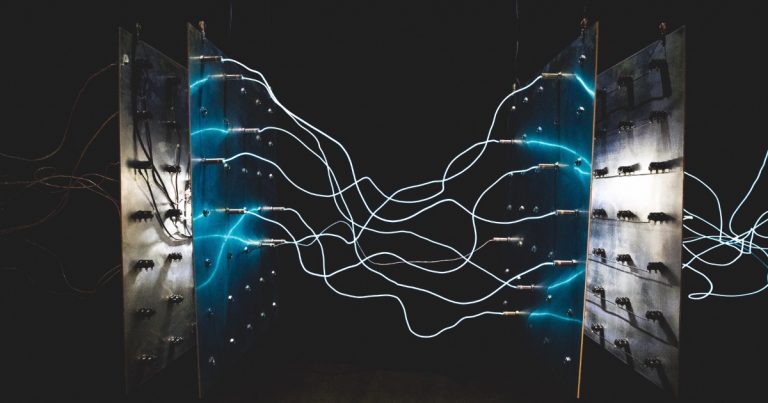Successful experience of using Qbic in a multimedia device management system at the Ural Federal University
Qbic and iRidi joint solutions continue to expand geography of its presence. Another new project – equipment of the Ural Federal University – says Anton Pavlovich SmolinHead of the Department of Design and Operation of Multimedia Complexes at UrFU.

For many years, UrFU has been pursuing a policy of active implementation of software and hardware videoconferencing to implement the educational process and ensure interuniversity interaction. In parallel with this, there is a consistent development of the multimedia infrastructure of the university classrooms. At the same time, the emphasis is on developing unified approaches to equipping classrooms and ensuring the possibility of planning painless modernization of the classroom (if additional requests for functionality arise in accordance with the requirements of the time and the current situation). Thus, in modern realities, UrFU is making a seamless transition from using the classical model of software and hardware videoconferencing in the educational process to the model of hybrid classrooms. In fact, the transition to a hybrid model at UrFU is not an innovation, but only a step in scaling previously proven approaches to a new level. This is a synthesis of the experience acquired during the development of the multimedia infrastructure of URFU, and the experience of the rapid implementation of remote synchronous forms of learning based on cloud services into the educational process.
All UrFU classrooms equipped with multimedia equipment require the installation of some form of automation systems based on push-button controllers or freely programmable controllers paired with touch control panels. In the context of the departure of many Western vendors in the field of automation from the market, the emphasis was placed on the implementation of iRidi control systems in conjunction with touch-screen tablet installation computers based on Android, namely, with devices from the Qbic model range, as the most suitable for the tasks of the university.
If we talk about specific examples of projects based on the above equipment, implemented over the past few months, we can give an example with equipping classrooms. Today, the total number of iRidi controllers and Qbic panel computers installed in classrooms and halls of the university amounts to dozens.
But let's talk about specific implementation examples in more detail.
As part of the planned re-equipment of the university's auditorium, one of the lecture halls of the general auditorium of the university and the UrFU Press Center was modernized – this is a dual-purpose hall, which is used as a press center and as a hall for dissertation defenses and the organization of the educational process.
During the modernization, we applied a typical scheme for equipping such classrooms and installed a fairly complex multimedia complex, which included microphones, amplifiers, monitors, DSP processors, microphone arrays, PTZ cameras and other equipment that is a necessary element of halls of this type .
To control the equipment, a control system was provided based on iRidi controllers and Qbic computers. Moreover, for the press center, Qbic was installed on a desktop optional mount, and for the classroom – on a wall mount. In this case, two different indoor work scenarios took place. A control interface for the operator has been launched in the press center on Qbic, and for the teacher in the classroom. Accordingly, the approaches to creating interfaces in both cases differ, but the main task is to provide the teacher and operator with an intuitive user interface.
Let's say, for a teacher, basic functionality has been implemented – the ability to control a camera, a microphone, as well as matrix switching on display equipment from one touch screen. For example, a teacher can display the required video content on the desired TV panel or personal monitor: an image from a camera (front or located in the back of the classroom), a remote speaker, a presentation from the HDMI output of a laptop or lecture computer, video from a content camera.

We tested installation panel computers from different manufacturers and deliberately settled on Qbic solutions. In particular, when choosing, we were guided by the presence of PoE power in the tablets, size, brightness, ease of integration with iRidi, the ability to run a project in full screen mode + the presence of a kiosk mode (since we also support projects on iRidi and program for it ourselves ), reliability parameters and the presence of additional functionality to expand the functionality of the control system in the future.




The concept of developing hybrid learning is such that we rely on the unification of equipment and the ability to use it with any video conferencing software services – teachers at the current stage can choose video conferencing services themselves depending on the task. The main idea is that the teacher should be comfortable regardless of which video conferencing platform he is used to working with.
The equipment of the classroom fund at UrFU is planned, and we continue to plan to use domestic control systems based on iRidi in conjunction with Qbic panel computers, since they completely cover the tasks that we face. In particular, it is planned to equip several halls and classrooms in 2024, and this equipment is also provided for by projects in new buildings of UrFU, the construction and design of which is actively underway at the moment.
A system integrator took part in the development of the mentioned solutions Extend Media.





